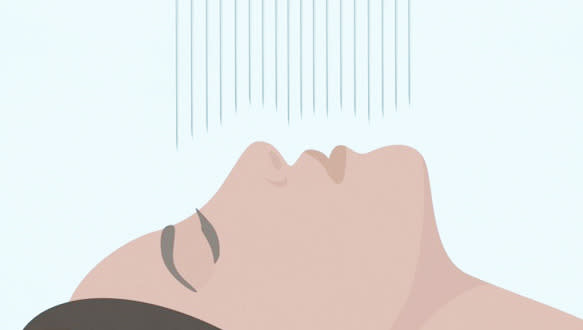Why Everyone is Talking About Microneedling

Newest data released by RealSelf today says microneedling will be the hottest aesthetic trend in 2016. (Illustration: RealSelf)
By Cheryl Wischhover for Charlotte’s Book
There’s a good chance this isn’t the first time you’re hearing about microneedling. For the last year two years, media outlets like The Wall Street Journal, New York Magazine, and Byrdie have reported on the prickly treatment. According to data released by RealSelf today, the procedure will be the hottest aesthetic trend of 2016, as predicted by the majority of 500 board-certified doctors polled by the site. Additionally, the site has seen a 57% increase in interest in the treatment by readers since it became a topic in forums there. We reached out to our national directory of Charlotte’s Book experts to find out more.
A Thousand Tiny Needles
Microneedling works much the same way lasers do, but via a much more low-tech mechanism. Doctors roll a device covered with needles—the length varies depending on the goals for therapy—all over the face, which mechanically pokes tiny holes into the skin’s surface, thus causing micro-injury and inflammation. This prompts the skin to stimulate collagen production in response to the injury. Collagen, of course, is the key to filling in fine lines, improving elasticity, and plumping the skin, all of which contribute to a younger look.
Who’s A Good Candidate For Microneedling?
According to Charlotte’s Book Premiere Provider and New York City dermatologist Dr. Doris Day, who says she’s had more requests than ever for the procedure this year, lots of people. “It can even out skin tone, and it can improve delivery of antioxidants into the skin,” she says. “For someone with something like melasma, microneedling may be the standard of care treatment in the future.” It’s also great for acne scars, fine lines, skin rejuvenation, and general discoloration. Generally, patients need about six to ten monthly treatments, followed by maintenance. Treatments take anywhere from 15 minutes to an hour, depending on the surface area and condition that’s being treated.
Dr. Day capitalizes on the skin’s ability to absorb topical treatments better after microneedling by treating patients with antioxidant formulas from brands like SkinCeuticals and SkinMedica. Dr. Mitchell Kline, another Premiere Provider and New York City-based dermatologist, has added hyaluronic acid and moisturizers prior to microneedling “so it’s inoculated into the skin.” He also does microneedling with platelet-rich plasma (PRP) therapy, commonly known as the vampire facial. (This procedure was thrust into notoriety when Kim Kardashian had it done on national television.) Patients get their own blood collected, then the sample is spun until just the plasma is left over. The plasma, which is applied to the skin during microneedling, helps to increase collagen growth even more.
Post-Needling Products: Be Careful What You Use
However, there’s a downside to the skin being able to absorb treatments more easily after microneedling. “I’ve seen scarring from [topical treatments] that shouldn’t be used because they either have preservatives or silicone in them,” Dr. Day says. “You basically get a foreign body reaction and that can last months to years.” Dr. Kline agrees, and says his patients go home with strict instructions about what they can and can’t put on their skin for the 48 hours after treatment.
The New Frontier—Microneedling + Radio Frequency
The newest innovation in microneedling is the EndyMed Intensif, which combines traditional microneedle therapy with radio frequency. The device received FDA approval in 2014. Dr. Day, who treats patients with it, says that it can accomplish the same things as traditional microneedling in less treatments. It’s also effective as a treatment for stretch marks and cellulite, so this is definitely something to watch. (A note: it’s more expensive than microneedling alone.)
While microneedling sounds great in theory, there’s no real data or large-scale clinical studies to back it up, according to both doctors. “I still think it’s a little bit of the wild, wild west. We don’t really have standardized protocols or data on this technique,” says Dr. Day. “People are doing it and certainly I’m doing it, and my colleagues and I have developed a protocol that works for us. But people think that because it’s not a laser, it’s safe and that anyone can do it anywhere, but the reality is we don’t know enough about it to make a broad statement about who should be getting it, how often and what should be used with it.” Dr. Day says she is starting a clinical study with her colleagues soon. Dr. Kline relies on in-office imaging. “We use serial photography and the Reveal machine [to track results],” he says. “We like to see what’s real compared to what the patient thinks has happened. We want patients to have appropriate expectations.”
Should You Try This At Home?
Finally, there are a lot of stories out there about people trying at-home versions of microneedling, and indeed, the handheld devices are pretty easy to buy online. But proceed with caution, warn both doctors. “You are creating a wound in the skin and any time you wound the skin you get the potential for a scar. And if [the device] gets dull you could be creating more problems than you’re helping,” says Dr. Day. If a dermatologist recommends one to you, that’s a different story, but use it as directed.
As with any cosmetic procedure, if you’re thinking about getting microneedling, be sure that your doctor has lots of experience with it first.
More from CHARLOTTESBOOK.COM
Innovative New Treatments In Aesthetic Dermatology Available Right Now

